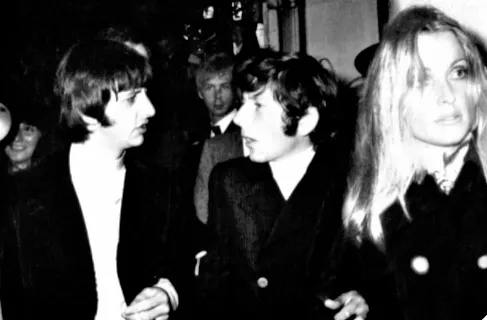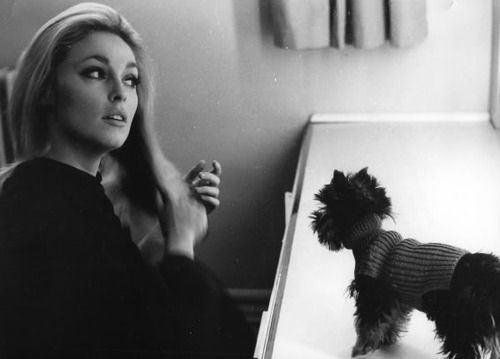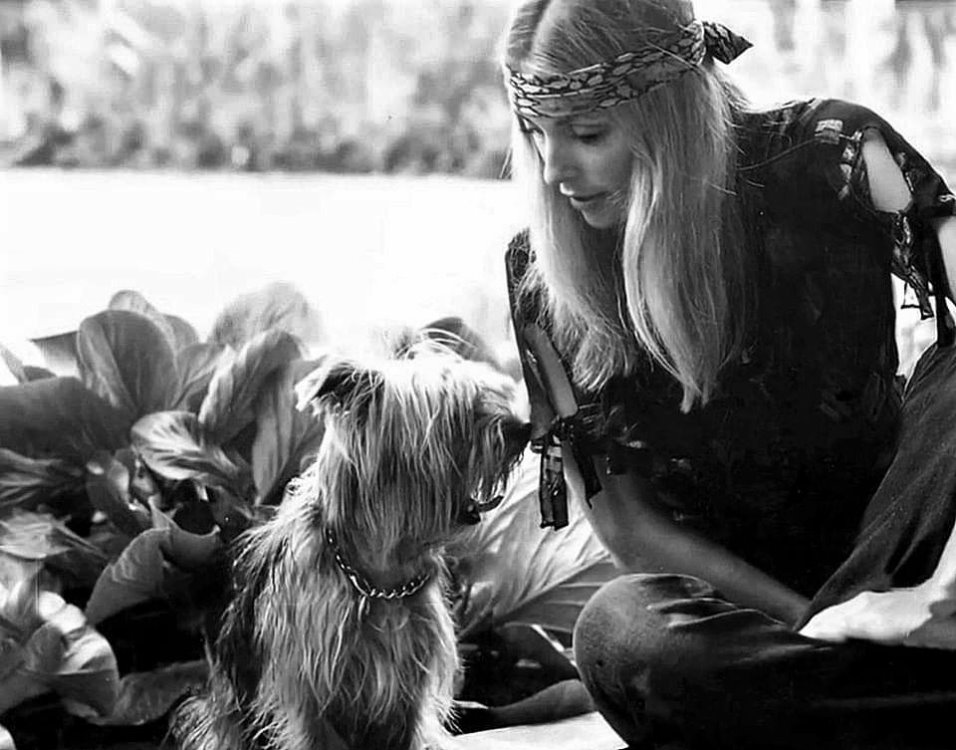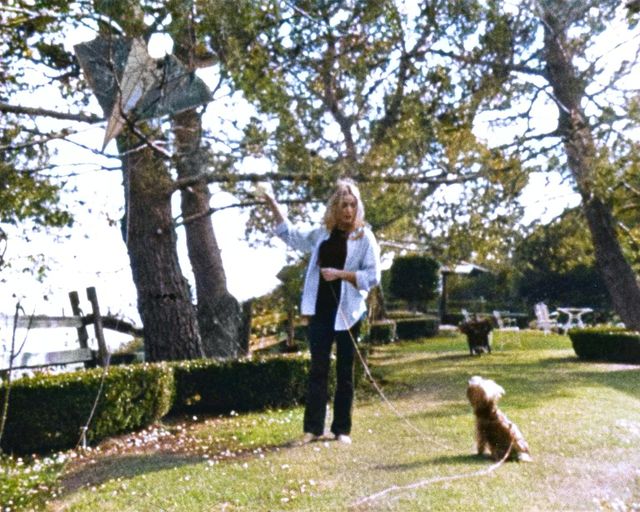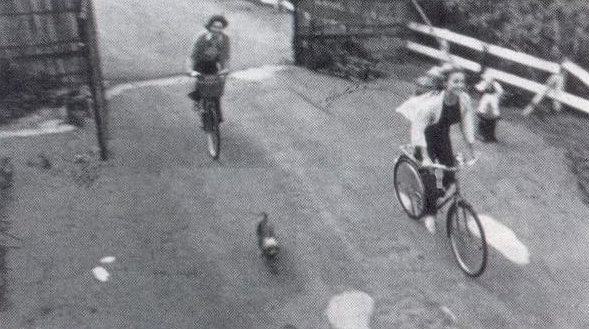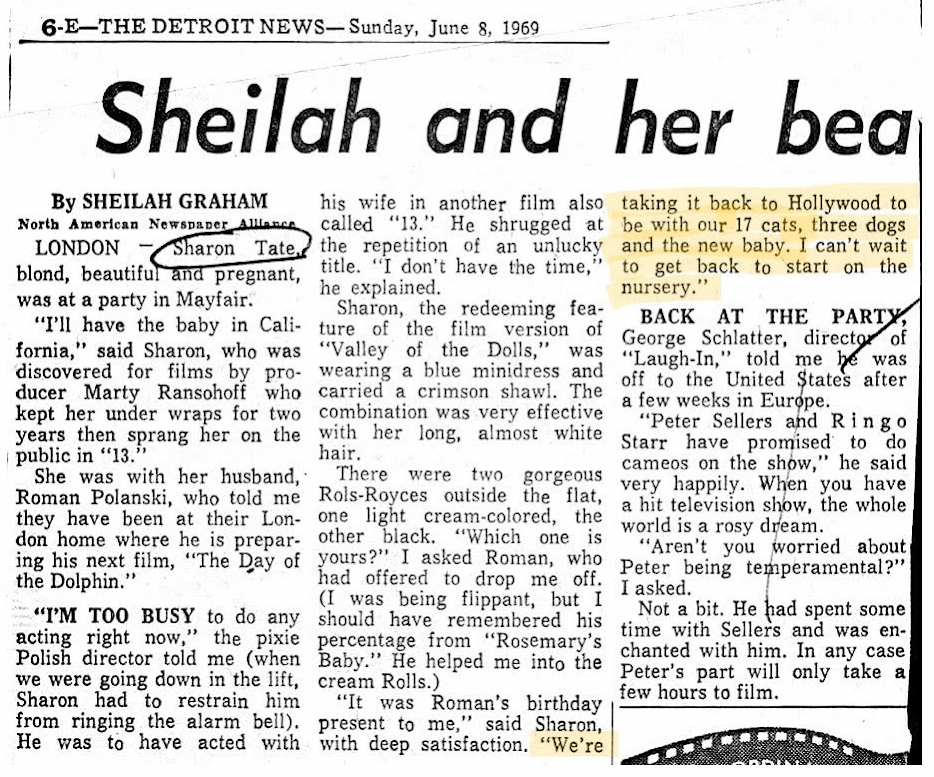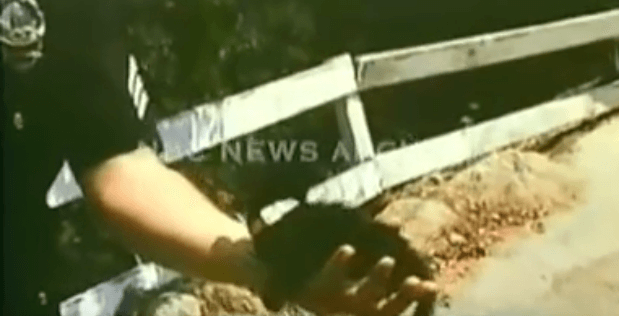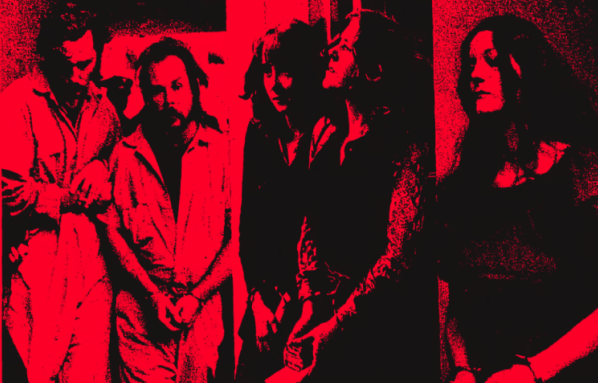A Chain of Events
Sharon Tate called it the house of love, but the residence at 10050 Cielo Drive turned out to be a house of horror. On a hot summer night in August 1969, pregnant actress Sharon Tate, along with Jay Sebring, Abigail Folger, Wojciech Frykowski, and Steven Parent were brutally murdered by members of the Manson Family.
Nestled in the Benedict Canyon hills, the Cielo Drive home initially exuded an air of opulence and tranquility. Its picturesque surroundings made it a haven for Hollywood elites seeking solace from the chaotic glamour of Los Angeles. The residence was secluded, yet cocooned by neighboring homes, offering both a sense of privacy and security.
A chain of events was set in motion when Rudolph Altobelli, a prominent Hollywood agent and owner of the property, leased the house to producer Terry Melcher. Known for his work with groups like The Beach Boys, Melcher lived in the Cielo Drive house for about two and a half years with his girlfriend, actress Candice Bergen.
In 1968, Terry Melcher met Charles Manson while visiting the home of Beach Boys drummer Dennis Wilson. Manson had befriended Wilson and spent much of the summer at Wilson’s house on Sunset Boulevard. This connection with Manson and the music industry played a significant role in the events leading to the infamous Tate-LaBianca murders.
The following account has been assembled through a careful review of trial testimony, police reports, court documents, interviews with those directly involved, and books, particularly those authored by members of the Manson Family. Together, these sources reconstruct the events that unfolded.
They Told Me They Too Had a Guru
While on the way to the Santa Monica Mountains to take an acid trip, Dennis Wilson and his personal assistant picked up two girls who were hitchhiking. Wilson told them about his involvement with the Maharishi and they told him they too had a guru, a guy named Charlie.
“I went up into the mountains with my houseboy to take an LSD trip. We met two girls hitchhiking. One of them was pregnant. We gave them a lift, and a purse was left in the car. About a month later, near Malibu, I saw the pregnant girl again, only this time she’d had her baby. I was overjoyed for her and it was through her that I met all the other girls.”
“I told them about our involvement with the Maharishi and they told me they too had a guru, a guy named Charlie who’d recently come out of jail after 12 years. His mother was a hooker, his father was a gangster, he’d drifted into crime but when I met him I found he had great musical ideas. We’re writing together now.” (Dennis Wilson: I Live with 17 Girls, 1968, Record Mirror)
When Wilson was introduced to Manson, he was immediately captivated by his charisma, and he let Manson and the girls stay at his home located at Sunset Boulevard for most of the summer. Wilson had no complaints. The girls cleaned his house, ran errands, and prepared dinner every night. The girls even did garbage runs in Wilson’s Rolls-Royce.
The Texan
One day, Dennis Wilson was hitchhiking—both of his cars had been wrecked—when a young man named Charles ‘Tex’ Watson gave him a ride. Out of appreciation, Wilson invited Tex Watson back to his mansion, where he met Charles Manson. The two quickly became friends. Little did Wilson know that Tex Watson would later become infamous for the mass murder of Sharon Tate and her guests.
Cease to Exist
Through his relationship with Dennis Wilson, Manson was able to network with prominent figures in the music business, including producer Terry Melcher and singer/songwriter Neil Young, who had several jamming sessions with Manson. The Beach Boys recorded and released one of Manson’s songs, ‘Cease to Exist,’ which was reworked into ‘Never Learn Not to Love.’
The track was recorded in 1968 and released as the B-side to the Beach Boys’ single ‘Bluebirds over the Mountain.’ Wilson made minor changes to the lyrics and added his own backing vocals. The song was not a commercial success, but it has since become a cult classic – pun intended. According to Wilson, Manson voluntarily traded his songwriting credit for a wad of cash and a motorcycle.
The Other Producer
During this period, Manson met up with an acquaintance from prison. Before his release in 1967, Manson had met producer Phil Kaufman, who was serving time on marijuana-related charges. After his release, Manson reconnected with Kaufman and was introduced to Kaufman’s friend, Harold True.
Manson visited Harold True’s home multiple times during the summer of 1968. This detail might have been insignificant, except for the fact that the LaBiancas moved in next door to True—and would be murdered by the Manson Family the following summer.
Interlude: Pooh Bear
On April 15, 1968, Valentine Michael Manson, the son of Charles Manson and Mary Brunner—the first member of the Manson Family—was born. Nicknamed Pooh Bear, he was named after the main character from the book Stranger in a Strange Land. Just eight days later, on April 23, 1968, he was taken from Manson and Brunner when the group was found sleeping naked in the woods. He was later reunited with his parents.
A Ride Back Home
In the summer of 1968, Terry Melcher visited Dennis Wilson at his Sunset Boulevard home, where he met Charles Manson, who was referred to as ‘The Wizard.’ Manson played guitar and sang his songs for them. Later that day, Wilson and Manson gave Melcher a ride back to his house at 10050 Cielo Drive.
Gregg Jakobson, a talent scout and close friend of Melcher, temporarily lived with Dennis Wilson. During this time, Jakobson befriended Charles Manson and Tex Watson. Throughout the summer of 1968, Tex Watson, Gregg Jakobson, and Dennis Wilson visited Terry Melcher’s home multiple times. Jakobson would later convince Melcher to audition Manson.
The Rookie and the Reverend
Tex Watson even smoked some weed in the living room of 10050 Cielo Drive with Terry Melcher and Dean Moorehouse, a former minister who had joined Charles Manson’s group. About a year later, Watson would commit the horrific act of killing Sharon Tate and Jay Sebring in that very living room.
This was Watson’s first visit to 10050 Cielo Drive. As he later recalled, “It was the first time I’d been to the house, but it wouldn’t be the last.” That same day, Moorehouse brought Watson to Spahn Ranch for the first time. The two locations would become forever linked in infamy.
Tex Watson was introduced to Dean Moorehouse at Dennis Wilson’s place, and both lived there for a time. Despite their age difference, the 23-year-old Watson and the 48-year-old Moorehouse quickly became friends.
Dean Moorehouse, also known as Baba, had met Manson in 1967, when Manson was in the early stages of forming what would become known as the Manson Family. Both Moorehouse and his teenage daughter joined Manson’s group.
Moorehouse was the one who introduced Watson to LSD. By the time he testified at Watson’s murder trial in 1971, Moorehouse stated that he had personally taken approximately 150 to 200 LSD trips—an average of about one trip per week.
“Dean Moorehouse took me on my first acid trip. Now it wasn’t just the external world I saw differently. It seemed the LSD opened me up to what was inside me as well.” (Watson, Will You Die for Me, 1978)
Due to his relationship with Moorehouse, Watson eventually ended up living at Spahn Ranch, the Manson Family’s headquarters during the Tate-LaBianca murders.
While at the ranch, Watson committed eight murders—nine, including Sharon Tate’s unborn baby.
Terry Melcher’s Jaguar
In the summer of 1968, Tex Watson and Dean Moorehouse embarked on a road trip. Moorehouse had to appear in court on charges of selling LSD, and Watson accompanied him for several weeks. They drove north in Terry Melcher’s brand-new 1968 Jaguar XKE, which he had loaned them along with his credit card, offering to cover gasoline and other expenses.
In his trial testimony, Watson recalled, “Dean had already picked up the car and he had asked me to come along with him on the trip, when we moved out of Dennis’ house, and went by Terry Melcher’s house to pick up his credit card. I remember we sat around in the front room, Dean and Terry and I, and we smoked some Marijuana together.”
On their way to the trial, they drove past Atascadero, where Watson received a speeding ticket. Two years later, he would return to Atascadero, this time as an inmate in a mental hospital facing murder charges.
According to Watson, Moorehouse had extensive knowledge of the Bible and preached throughout the entire trip. Moorehouse’s trial lasted two days, but the jury couldn’t reach a verdict, leading to the scheduling of a second trial. They stayed in Mendocino for several weeks before returning to Los Angeles.
Something Had Upset Wilson
Around this time, Dennis Wilson moved out of his Sunset Boulevard home, where Tex Watson and Dean Moorehouse had been staying for the summer. A recording session gone wrong had strained the friendship between Wilson and Manson, setting the stage for a growing divide.
One day, during a recording session at Brian Wilson’s state-of-the-art home studio, Brian and several musicians suggested that Manson make changes to his music, such as altering the rhythm and revising some of the lyrics. Manson, who detested anyone meddling with his music, reacted strongly. Although the studio was soundproof, Dianne Lake later recalled hearing an argument so loud that it reached her outside by the swimming pool.
At one point, Manson stormed out in anger, leaving Brian Wilson and the other musicians visibly shaken. They all returned to Dennis Wilson’s house, where Manson seethed, complaining that they wanted to change his music, his style, and even him. Dennis Wilson’s brothers expressed concerns about his association with Manson and urged him to sever ties. From that moment, the relationship between Wilson and Manson began to deteriorate.
Dennis Wilson eventually moved out of his home and moved in with Gregg Jakobson, but he allowed Manson and the girls to continue using the Sunset Boulevard house until the lease expired. When the lease ended, Manson and his group relocated to Spahn Ranch, an old movie ranch turned horse rental business.
Although their friendship wasn’t entirely severed—Manson visited Wilson at his new home, and Wilson made several trips to the Spahn Ranch—this period marked a dramatic shift in their relationship. Tensions escalated further when the Beach Boys released Never Learn Not to Love several months later. Despite Manson writing the song, his name was omitted from the credits.
When They Returned
When they returned from their road trip, Tex Watson and Dean Moorehouse stopped in San Francisco to visit one of Moorehouse’s friends, acquired some acid, and indulged in a couple of trips. Upon their return from San Francisco, they spotted Manson riding a motorcycle.
“We saw Charlie riding around one motorcycle and he led us up to a place where Dennis Wilson had moved, not the old place, but a new place in Malibu.” (Excerpt from Watson’s trial testimony)
Following Manson, they arrived at Dennis Wilson’s new place in Malibu, where they spent the night. However, an incident between Moorehouse and one of the girls at Wilson’s former home had seemingly upset Wilson.
According to Watson’s testimony, “I think he was kind of mad at Dean or something because of something that happened in the old house, something with Dean and one of the girls in the old house, I believe, so Dean really didn’t want to stay with him and suggested we go out and stay with Manson at the ranch.”
Feeling uncomfortable around Wilson, Moorehouse asked Manson if they could join his group at Spahn Ranch. Manson reluctantly agreed, wary of the old, bearded minister who had been pursuing his girls, and of Watson, who seemed hesitant to fully commit to the group.
“Charlie didn’t want us at Spahn Ranch. I still had too much ego, he said, and he didn’t want a horny old man like Dean going after his young loves.” (Watson, Will You Die for Me, 1978)
Despite his reservations, Manson provided them with a tent, which they set up next to a dry creek bed at the ranch. From that moment on, Tex Watson began living with the Manson Family.
Interlude: Susan Atkins Son
In October 1968, Susan Atkins, who would later be convicted of murdering a pregnant woman, gave birth to a son. She named him Zezozose Zadfrack Glutz. Born prematurely at Spahn Ranch, the baby’s umbilical cord was cut by Dianne Lake, at Charles Manson’s request—using her teeth.
The boy was later adopted while Atkins was in prison, renamed Paul, and never had contact with his mother again. In a striking twist, Sharon Tate’s unborn son would also be named Paul and would never have the chance to know his mother.
Fate Had Other Plans
During his time at Spahn Ranch, Tex Watson became close to Manson and the group but did not yet join permanently. He left for several months, and history might have changed if he had not returned to Manson.
On December 2, 1968, Watson reported for military duty. Had he enlisted that day, he would likely have been sent to Vietnam. However, fate had other plans. Watson was deemed unfit due to a knee injury sustained in a car accident earlier that year and received a one-year deferment.
Around this time, Moorehouse was found guilty in a retrial and sentenced to six months in prison. Watson left the Manson clan for several months to live with a friend in East Los Angeles. However, the allure of Manson, the women in the group, and the communal lifestyle proved too strong to resist, and he returned to Manson in early 1969.
A Stranger Arrived
In January 1969, Terry Melcher and Candice Bergen moved out of the Cielo Drive residence, unbeknownst to Manson. On February 12, 1969, Roman Polanski and his pregnant wife, Sharon Tate Polanski, signed a one-year lease for the house. They moved in three days later.
On March 23, 1969, a stranger arrived at 10050 Cielo Drive. Shahrokh Hatami, a friend of Sharon’s, approached the visitor and questioned the man’s presence. The man replied that he was looking for Terry Melcher.
Hatami informed the man that Melcher no longer lived there and that the Polanskis now occupied the house. He suggested checking the guesthouse, where Altobelli lived, as the people he was looking for might be there.
Just as the visitor was about to leave, Sharon came to the door and asked Hatami who he was. Hatami explained that the man was looking for Terry Melcher. Sharon and the stranger briefly faced each other. It was later revealed that the man who visited Cielo Drive that day was Charles Manson.
“Mr. Hatami said that, while he was speaking to the stranger, whom he later identified from photographs as Manson, Miss Tate came to the door to see what was happening. He said that she had seen Manson and that he had seen her.” (Manson Put at Tate Home 5 Months Before Murders, 1970, New York Times)
Later that day, Manson returned to the guest house. He encountered Rudi Altobelli, the proprietor of 10050 Cielo Drive, in the process of packing. Altobelli and Sharon Tate were preparing to leave for Rome the next morning.
Manson introduced himself, but Altobelli responded with a dismissive demeanor, mentioning that they had already crossed paths during the previous summer.
“It was about 8 or 9 p.m. the day before I left,” Altobelli said, “and I was showering when I heard my dog Christopher barking. Charles Manson was at the door. I asked what he wanted and he started to introduce himself and I said, ‘I know who you are, Charlie.’”
Rudi Altobelli had met Charles Manson a year before the Tate murders at the residence of Dennis Wilson, the Beach Boys’ drummer. At that time, Altobelli, along with Dennis Wilson and Gregg Jakobson, were listening to some of Manson’s music.
Q. And how long were you in Mr. Manson’s presence on this occasion at Dennis Wilson’s home?
A. 20 minutes approximately. Approximately 20 minutes.
Q. Who else was present at that time in addition to yourself and Mr. Manson?
A. Dennis Wilson, Gregg Jakobson, a little boy maybe three or four years old, I don’t know, and three girls–three or four girls.
Q. Did you listen to any musical recordings of Mr. Manson?
A. Yes. Dennis was playing a tape that Charles Manson had recorded.
About Gregg Jakobson
Gregg Jakobson, a close friend of Terry Melcher, met Charles Manson and Tex Watson at Dennis Wilson’s home. He became a frequent visitor to Spahn Ranch, the central hub for Manson’s activities.
Spending significant time with Manson and his clan, Jakobson felt almost like a member of their Family. He engaged in drug use with the group, staying overnight at both Spahn Ranch and Death Valley.
Jakobson ventured to the ‘bottomless pit’ in the desert, a place Manson often preached about. They would drop rocks down the deep hole, yet the sound of the rock hitting the bottom never reached their ears.
“Well, I saw the bottomless pit, or I saw what was, you know, I was there. That was one of the far-out fascinating things about this. I wanted to film it. That was one of my goals, you know. That’s why I involved some people.” (Excerpt from Gregg Jakobson’s trial testimony)
Interlude: BellaDonna
On April 23, 1969, Tex Watson was arrested for public intoxication. He had consumed tea brewed from the roots of Belladonna, a potent psychedelic. Watson was found crawling on the sidewalk through a crowd of schoolchildren, repeatedly saying, “Beep, beep, beep.”
He spoke of little green men and space people. The trip lasted for ten days. When arrested, Watson’s fingerprints were taken for the first time in his life. These fingerprints would later be linked to the murder scene at 10050 Cielo Drive.
Still Deeply Involved
During the spring of 1969, Sharon Tate and Roman Polanski both traveled to Europe for two different film projects. Polanski was scouting locations for ‘The Day of the Dolphin,’ while Tate starred in what turned out to be her final movie, ‘The Thirteen Chairs.’
Meanwhile, Gregg Jakobson, still deeply involved with Manson and the girls, attempted to persuade Terry Melcher to visit Manson at the ranch and explore the possibility of creating a documentary about the group.
Jakobson, who later wrote about his time with Manson under the pseudonym Lance Fairweather, believed Manson’s music could only achieve public acceptance if he was first introduced through a documentary film.
Melcher agreed to audition Manson and visited Spahn Ranch in May 1969. The audition took place in the backwoods of the ranch. Manson sat on a rock, singing his songs while the girls provided background vocals.
Melcher told Manson that if he wanted to record professionally, he would need to join a union—a suggestion Manson declined. Instead, Melcher offered to bring a mobile recording studio to the ranch. And so he did.
Legend Has It
Melcher asked Mike Deasy, a renowned guitarist who had played with Elvis Presley on the 1968 Comeback Special, to visit Manson at Spahn Ranch and bring along his mobile recording studio.
Deasy stayed at the ranch for several days and dropped acid with the Family. Legend has it that during a bad trip, Deasy became convinced that Manson was the devil and chased him with a pitchfork. Following this incident, Deasy severed ties with Manson and never visited the ranch again.
His stay at the ranch, along with taking so much acid that he couldn’t come down, had such a profound effect on him that he required psychotherapy, meditation, and eventually a visit to Pastor Billy Graham to recover.
According to Deasy, reflecting on his time with Manson: “I took so much acid, I couldn’t get down. I tried everything I could. I went to Jungian analysis, I went through transcendental meditation, and nothing was working.”
Melcher Witnessed a Fight
During his second visit to the ranch, Melcher witnessed a fight between Manson and Randy Starr, a ranch hand. On that same day, Starr emerged from his trailer, drunk and brandishing a gun. Manson beat up Starr and disarmed him. The incident unnerved Melcher, who decided to distance himself from Manson after the altercation.
Gregg Jakobson recounted the scene as follows: “See, the second time at the ranch Terry and I and Charlie were sitting down by the stream, and Charlie was singing.”
“And Randy Starr, this old Hollywood stuntman, was drunk and goofing off and waving his gun around. And Charlie yelled, “Don’t draw on me, motherfucker!” and went over and beat the shit out of him right in front of us.”
Once Tate Wrapped Filming
In July 1969, once Tate wrapped filming, she returned to their Cielo Drive home, while Polanski remained in Europe to finish his project. Both desired their baby to be born in the United States. Polanski was scheduled to return home on August 12.
While Tate and Polanski were in Europe, Polanski’s friend Wojciech Frykowski and his girlfriend, Abigail Folger, stayed at 10050 Cielo Drive to house-sit. Since Polanski was still overseas, Frykowski and Folger decided to stay with Sharon until he returned.
In August of 1969, Sharon Tate, in the last stages of her pregnancy, was preparing to give birth to a baby. She was picking out names, buying baby clothes, putting the final touches on the nursery, and maintaining a healthy diet for the sake of the baby. She was ready to bring a new life into the world.
A Different State of Mind
Meanwhile, Manson and his clan were in a different state of mind. Tex Watson had just robbed a drug dealer, Bernard ‘Lotsapoppa’ Crowe, who was rumored to be a member of the Black Panthers. Crowe contacted Manson, demanding his money back and threatening to kill everyone at Spahn Ranch. Manson sent Watson into the hills with a sleeping bag and told him he would take care of the situation.
Manson went to the drug dealer’s apartment to smooth things over, but it ended with Manson shooting him. Manson believed he had killed Crowe, who had actually played dead. It was only during the Tate-LaBianca trial that Manson learned Crowe was still alive. Because Manson thought he had cleaned up Watson’s mess, Watson owed him a favor—a blood debt that would be collected on the night of August 8, 1969.
The Crowe shooting set off paranoia within the Family. Armed foot patrols were organized around the ranch in anticipation of retaliation by Crowe’s supposed Black Panther associates.
Several Weeks Later
Several weeks later, the first Manson Family murder occurred when Bobby Beausoleil, Susan Atkins, and Mary Brunner killed Gary Hinman, an associate of the Family with whom Beausoleil had lived before meeting Manson.
Multiple theories surround the Hinman murder. Beausoleil claims that Hinman sold him bad dope, and he wanted his money back. Another theory suggests Manson ordered the group to rob Hinman. Regardless of the motive, the outcome was fatal.
They held Hinman captive and tortured him for several days before killing him. Manson slashed Hinman’s face with a sword, nearly severing his ear, while Bruce Davis held him at gunpoint. Eventually, Beausoleil stabbed his former friend to death.
Beausoleil left a bloody paw print on the wall with the words ‘Political Piggy’ written in Hinman’s blood, attempting to mislead authorities into blaming the Black Panthers. They then stole Hinman’s cars and bagpipes before fleeing the scene.
A Hidden Knife
A couple of days after the Hinman murder, the California Highway Patrol found Beausoleil asleep in Hinman’s Fiat station wagon. Upon running the license plate, the officer was alerted by the dispatcher that the car had been reported stolen.
Beausoleil was booked for suspected car theft on August 6, 1969, at the San Luis Obispo Sheriff’s Office. A search of the vehicle uncovered the murder weapon used in Hinman’s homicide, a hunting knife, hidden in the tire well. The following day, August 7, Beausoleil was charged with murder.
Within Three Days
Within three days of Beausoleil’s arrest, Sharon Tate, Jay Sebring, Abigail Folger, Wojciech Frykowski, Steven Parent, and Leno and Rosemary LaBianca were murdered.
A common element among all the murder scenes was that the victims had all been stabbed, and the words “Pig,” “Piggy,” and “Pigs” were written in the victims’ blood.
Nevertheless, the homicide detectives failed to recognize the connection between the murders. They initially believed the LaBianca murders to be copycat killings because of the similarities to the Tate murders.
“On the night of the LaBianca murders he was asked by a television reporter if the Tate and LaBianca murders were related and regretted his answer. “I told him, ‘I think it’s more of a copycat case.’” (Danny Galindo Dies at 88; LAPD Detective in Tate-LaBianca Murder Cases, 2010, Los Angeles Times)
First Spahn Ranch Raid
The day after Gary Hinman was murdered, police conducted their first raid on the Spahn Ranch. The second raid occurred a week after the Tate murders.
Neither raid was connected to a search for the killers; instead, the group had drawn police attention due to suspicion of stolen cars and other unrelated activities.
Ironically, the group would be raided a third and fourth time after the murders in October 1969, again on charges unrelated to the killings. During all four raids, the police had no idea they were so close to capturing the killers.
The first Spahn Ranch raid, on July 28, 1969, was relatively small compared to the second, which became the largest police raid in California at the time. During the first raid, only a handful of squad cars arrived at the Spahn Ranch.
When the police arrived, they found Manson in his dune buggy just off the ranch. According to trial testimony, when asked what he was doing, Manson replied that he was watching for Black Panthers, who he said were expected to attack the ranch.
Manson then made a veiled threat, claiming that the people at the ranch were heavily armed and that machine guns were aimed at the officers. He even joked that if they stormed the ranch, they might be mistaken for Black Panthers and shot.
Police searched the buildings before inspecting the vehicles for stolen cars. At the ranch, they discovered one of Gary Hinman’s cars. It had not yet been reported stolen, and Hinman’s body had not been found. An officer remarked that he knew Hinman and assumed he was probably nearby, visiting.
Despite the threats, only one person was arrested during the raid: Johnny Swartz, the owner of a 1959 Ford. He was taken into custody for providing false evidence of registration.
Eleven days later, that same Ford would be used by the killers on the night of the Tate murders, as they drove to 10050 Cielo Drive.
Timeline of Sharon Tate’s Last Day
This is a timeline of August 8, 1969, Sharon Tate’s last day alive. For more details see the Tate Murders Police Report.
On the morning of August 8, 1969, around 11 a.m., the eight-and-a-half-month pregnant actress received a phone call from her husband, Roman Polanski, who was overseas working on a movie. Their conversation was longer than usual, during which they discussed a stray kitten Sharon had found and how she was caring for it.
Around 12:30 p.m., Sharon Tate had lunch by the pool with her actress friends Joanna Pettet and Barbara Lewis. Shortly after, Folger and Frykowski joined them. Her friends left around 3:30 p.m., and soon after, Sharon went inside to take a nap.
Before lunch, the housekeeper had washed down the front door because the dogs had dirtied it. This detail proved crucial, as her cleaning removed other fingerprints, making it easier for police to lift Tex Watson’s prints from the freshly cleaned surface.
In the afternoon, between 3 and 4 p.m., both Folger and Frykowski left the property. Folger drove off in her Firebird, while Frykowski took a yellow Camaro that Sharon had rented, as her red Ferrari was in the shop for repairs.
Around 4:30 p.m., Joe Vargas, the brother of the gardener, signed for two steamer trunks that had arrived from Europe, belonging to Sharon. Vargas signed for the trunks to avoid waking Sharon.
Around 5:30 p.m., Jay Sebring, Sharon Tate’s ex, was seen leaving his home on Easton Drive in his black Porsche. Around 6 p.m., Sebring arrived at the Cielo Drive home to check on the pregnant actress.
Earlier in the afternoon, Abigail Folger had purchased a new bicycle. Between 6:30 and 7 p.m., Dennis Hearst, the son of the bike shop owner, delivered it to the Cielo Drive residence. When Hearst delivered the bike, Jay Sebring answered the door.
In a strange twist, it was later discovered that Dennis Hearst was Marina Habe’s lab partner in biology class. Marina Habe was found dead in January 1969 and has long been rumored to have been an early Manson Family victim.
Later that evening, Tate, Sebring, Folger, and Frykowski reportedly went out for a late dinner at El Coyote.
Around 10 p.m., Abigail Folger’s mother called to confirm that Abigail would be flying to San Francisco the following day; her mother had planned a birthday party for her on August 11th.
Around 11:45 p.m., Steve Parent visited William Garretson, the Cielo Drive caretaker, in the guest house. Shortly after midnight, as Parent left, Altobelli’s dog, Christopher, possibly alerted by something, began barking.
Soon after, as Steve Parent drove toward the gate, he encountered Tex Watson, Susan Atkins, Patricia Krenwinkel, and Linda Kasabian, who had just entered the Cielo Drive property.
Not a Good Day
August 8, 1969, was not a good day at Spahn Ranch, Manson’s headquarters. After being involved in the murder of Gary Hinman, Manson had left town for a few days. Upon returning to Spahn Ranch at around 2 p.m., he received the news that his friend Bobby Beausoleil had been arrested for the murder.
The tension was rising. First, the Bernard Crowe shooting, followed by the Hinman murder, and now his friend had been arrested for the murder. But the day would go from bad to worse. Later in the afternoon, Mary Brunner and Sandra Good embarked on a shopping trip, using stolen credit cards.
Good, who was nearly eight months pregnant with Bobby Beausoleil’s child, and Brunner, the mother of Manson’s son, went to a department store and used the stolen credit cards. However, they were caught. The two women fled from the store, and after a car chase, they were apprehended and taken to jail.
Things began to unravel. Brunner, who was recently involved in the Hinman murder, is now heading to jail, although for a lesser offense. Brunner was booked at 10:21 p.m. on August 8, 1969. About two and a half hours later, Sharon Tate and her friends would be dead.
Leave a Sign, Something Witchy
On the night of August 8, 1969, Charles Manson allegedly told Tex Watson to “take some of the girls and go to that house where Melcher used to live” and to “totally destroy everyone inside, as gruesome as you can”, and to “leave a sign, something witchy”.
According to Tex Watson, Manson told him they needed money to bail Mary Brunner out of jail. “If you don’t get enough money at the Melcher house, then go to the house next door, and then the one after that until you get six hundred dollars.”
Tex Watson took Susan Atkins, Linda Kasabian, and Patricia Krenwinkel to Cielo Drive. When they arrived at the entrance of the Cielo Drive property, Watson climbed a telephone pole near the gate and cut the phone line to the house. At this point, it was almost midnight.
Abigail Folger was reading a book in her bedroom, Wojciech Frykowski had fallen asleep on the living room couch, and Sharon Tate and Jay Sebring were talking in her bedroom when Tex Watson slid open a window screen and entered the house. Once inside, he opened the front door to let Krenwinkel and Atkins in.
“I went over to Sharon Tate, and I flashed, wow, there’s a living being in there. I wanted to, but I couldn’t bring myself to cut her open and take the baby. I knew it was living, I knew it wouldn’t live…” (Susan Atkins’ Story of Two Nights of Murder)
On the morning of August 9, 1969, Winifred Chapman, the housekeeper at 10050 Cielo Drive, arrived for work, unaware of the horrific scene that awaited her. After discovering the bodies, she ran out and called for help. The police dispatch put out the call: “Five down on Cielo Drive.”
When police searched the property, the dogs belonging to Sharon Tate, Abigail Folger, and Wojciech Frykowski were found hiding in a closet. A stray kitten that Sharon had been caring for was also found at the murder scene.
Roman Polanski was still in London when he received the news that Sharon had been killed. It was around 7:00 p.m. London time when the call came in. His longtime friend Andrew Braunsberg answered the phone and received the news from Polanski’s agent, Bill Tennant, who told them, “A disaster happened at the house. They’re dead. They’re all dead.”
Meanwhile at Sybil Brand
Meanwhile, at Sybil Brand Jail, Mary Brunner reached out to Melba Kronkright, also known as Malibu Melba, an acquaintance of the Family, and asked her to bail her out. Brunner explained that her release required both money and a property owner’s signature. Kronkright refused.
Later that same night, Charles Manson visited Kronkright at her home and repeated the request for bail money. Once again, Kronkright refused. Kronkright later told police she was certain this visit occurred on the same night the LaBiancas, who owned a nearby grocery store, were murdered.
A Dog Greeted Them
On August 9, 1969, the nation woke up to the horrifying news of the Tate murders. On that fateful day, Leno and Rosemary LaBianca went to Lake Isabella to pick up Rosemary’s son, Frank, who was on a week-long holiday with a friend. Frank was having so much fun that the LaBiancas decided to let him stay another day. Around 9 p.m., Leno and Rosemary left Lake Isabella and drove back to Los Angeles.
Once home, Rosemary retired to the bedroom while Leno fell asleep on the couch reading the newspaper. In the early hours of August 10, 1969, Charles Manson and Tex Watson entered the LaBianca residence through an unlocked back door. A dog greeted them curiously, wagging its tail. After tying up the couple, Manson left and sent Leslie Van Houten and Patricia Krenwinkel inside. Not long after, Watson, Van Houten, and Krenwinkel slaughtered the LaBiancas.
Mr. Part: “Well, did the woman hear her husband die?”
Van Houten: “Oh, yeah. So her husband, so the woman heard her husband, she must have because all of a sudden she jumped up, and it surprised me. And she got the lamp shade, and she was about to knock me on the head with it, and I put it back, and she kept going, ‘What’s happening to Leo? What’s happening to Leo?’ And we kept telling her, ‘He’s allright, he’s allright.’ And then katie (Krenwinkel) tried to stab her, and the knife wasn’t strong enough. It kept bending. So we called Tex in.”
Following the brutal killings, Tex Watson showered and changed into some of Leno LaBianca’s clothes, while Krenwinkel and Van Houten wiped everything down to remove fingerprints and scrawled various phrases on the walls using Leno LaBianca’s blood. They helped themselves to some chocolate milk and cheese, patted the dogs, and hitchhiked back to Spahn Ranch.
“Katie (Krenwinkel) said there was a dog there in the house. She said the dog just sat and watched the whole thing. It couldn’t have been much of a watchdog. The dog came up to them and wagged its tail, and Katie reached down and patted its head before they left.” (Susan Atkins’ Story of Two Nights of Murder)
Interlude: Mondo Hollywood
Shortly after the murders, movies featuring Sharon Tate were reissued. Valley of the Dolls and The Fearless Vampire Killers returned to theaters. A 1967 movie featuring Jay Sebring, Mondo Hollywood, was also re-released. What wasn’t known at the time was that Bobby Beausoleil, one of the Manson Family killers, also appeared in the film.
Released on a Technicality
On the morning of August 16, 1969, the Los Angeles County Sheriff’s Department conducted a raid on the infamous Spahn Movie Ranch. Located at 12000 Santa Susana Pass Road, the ranch became the site of the largest police raid in California’s history at that time.
The law enforcement action was prompted by charges unrelated to the Tate-LaBianca murders. The discovery of stolen cars and car parts had captured the authorities’ attention. Unbeknownst to them, the individuals responsible for the brutal Tate-LaBianca murders were within their reach.
Over a hundred heavily armed officers encircled the ranch. The event was filmed with the intention of creating a training video for future raids. The land-air operation involved helicopters, horses, squad cars, and even a canteen truck to provide coffee for the officers.
Charles Manson and his group were arrested and taken to the Malibu police station for booking. However, they were all released on a technicality: it was discovered that someone had mistakenly put the wrong date on the search warrant.
Simply Ask Them To Leave
Manson suspected that one of the ranch hands had snitched on them, triggering the raid. The ranch hand in question, Donald Jerome Shea, also known as “Shorty,” worked at Spahn Ranch. Despite his nickname, Shea actually stood 6 feet 4 inches tall and weighed over 200 pounds.
George Spahn, the owner of Spahn’s Movie Ranch, wanted to hire Shea as a security guard. Frank Retz, who was in the process of purchasing a portion of Spahn Ranch, discussed the possibility of hiring Shea with Spahn. Retz had bought property next to Spahn’s Ranch and had set up his own residence in the area.
Retz disliked the presence of ‘hippie types’ around the ranch and wanted to get rid of them. Lynette Fromme and Ruby Pearl were present during the talk of hiring Shea. After the discussion, Shea assured Pearl that he wouldn’t have trouble with Manson and the group; he would simply ask them to leave. A couple of days later, Shea was killed.
In late August 1969, Charles Manson, Tex Watson, Steve Grogan, and Bruce Davis took Donald Shea on a ride. Upon a signal from Watson, Grogan struck Shea forcefully on the head with a pipe wrench, and Watson ruthlessly stabbed him multiple times. They then pulled Shea out of the car and stabbed him to death.
Ask the Black Panthers
Ruby Pearl, the ranch’s forewoman, gave the following statement to the police, “Some time late in August I went to Spahn’s Movie Ranch about 11:30 P.M. Shorty had been drinking and asked if he could come over to my house and stay because he didn’t like being around these weird hippies.”
“I told Shorty I didn’t have room at my house for him and got into my car and started to leave, when I observed a blue car pull into the ranch with Charles Manson, Tex Watson, Bill Vance, Bruce Davis and Clem Tufts (Steve Grogan) jumped out of the car very fast and spread out along the boardwalk. I thought it was strange as they never moved very fast.”
“I didn’t stop. I continued driving out of the ranch and never saw Shorty again. After Charlie was arrested I went to the County Jail with Dawn Quant to visit Charles Manson. I asked Charlie, ‘Where is Shorty’s body, Charlie?’ We want to bury him properly.’ Charlie answered, “Ask the Black Panthers.”
Into the Valley of Death
In October 1969, Manson Family member Kathryn Lutesinger provided crucial information to the police about the murder of Gary Hinman. Her statements led to the arrest of Susan Atkins for Hinman’s murder, which, in turn, triggered the arrests of other Manson Family members involved in the Tate-LaBianca murders.
Kathryn Lutesinger, also known as Kitty, was introduced to the Manson clan by Bobby Beausoleil, who also brought Leslie Van Houten and Catherine Share into the Family. Beausoleil, in turn, met Lutesinger through Gregg Jakobson.
Nicknamed Cupid, Beausoleil was quite popular with women. At the time of the Tate-LaBianca murders, both Kathryn Lutesinger and Sandra Good, another Manson follower, were pregnant with Beausoleil’s children.
Lutesinger lived on and off with the Manson Family at Spahn Ranch. In early August 1969, 17-year-old Lutesinger left the ranch to stay with her parents after Manson had reportedly threatened her. During this time, Beausoleil was arrested for the Hinman murder, and the Tate-LaBianca murders occurred. While staying with her parents, Lutesinger learned of Beausoleil’s arrest but was kept in the dark about the reason.
Lutesinger returned to Spahn Ranch on August 15, 1969. The next day, police raided the ranch, arresting her and the Manson Family. After their release, the group briefly remained at Spahn Ranch, during which Donald ‘Shorty’ Shea was murdered. Following Shea’s murder, Manson and the group moved to Death Valley, with Lutesinger joining them.
A Wild Animal
“The last few times I saw Charlie, he was like a wild animal. I wasn’t frightened, but I could just see it. It was like walking alongside a wild animal, his eyes . . . He wasn’t handling the city at all. He said to me, ‘I gotta get out of here.’ And I said, ‘Go to the desert, man. That’s where you belong.’” (Gregg Jakobson)
While in the Desert
While in the desert of Death Valley, Susan Atkins eventually revealed to Lutesinger that Beausoleil had been arrested for the murder of Gary Hinman, detailing the horrific events at Hinman’s residence and admitting her involvement in the murder. Shocked by this revelation, Lutesinger fled the group on the night of October 9, 1969, with Stephanie Schram, who had joined the Family after Hinman’s murder.
According to the police report, the two flagged down a police car and asked for help. The officers identified them as runaways and determined they might be connected to an active investigation. They were subsequently taken into custody. Lutesinger was brought to the San Dimas Sheriff’s Department, where, during questioning, she implicated Susan Atkins in the murder of Gary Hinman.
Coincidentally, the day after Lutesinger fled the group, Manson and his followers were arrested in the Barker Ranch raids in Death Valley on October 10 and 12, 1969. Ironically, their arrest was for a minor offense—vandalism in a National Park—that had nothing to do with Lutesinger’s escape. Once again, the authorities did not realize they had the individuals responsible for the brutal murders within their reach.
During her questioning on October 12, Lutesinger told police that she had heard from Susan Atkins that Atkins and Beausoleil had gone to Hinman’s residence, a fight had broken out, and Hinman had been killed. She also mentioned seeing both of Hinman’s cars at Spahn Ranch around the time of his murder.
Sexy Sadie What Have You Done
On October 13, Susan Atkins, also known as Sexy Sadie, was transported to the San Dimas Sheriff’s Station and booked on suspicion of murder. She was later taken to Sybil Brand Institute, a women’s detention facility. Although the perpetrators of the Tate-LaBianca murders had yet to be identified, Atkins made a startling confession to two fellow inmates, Ronnie Howard and Virginia Graham.
She bragged about her involvement in the Tate massacre, claiming she had killed Tate, tasted her blood, and written the word ‘Pig’ on the front door of the property in Tate’s own blood. Howard and Graham reported Atkins’s confession to the authorities. Soon after, those responsible for the murders were apprehended.
Watson Stopped Talking and Eating
After fleeing to Texas in October 1969, Tex Watson was arrested on November 30th for his involvement in the horrific Tate-LaBianca murders. For nine months, he fought extradition to California, but in 1970, he was finally returned to face charges of seven counts of first-degree murder and one count of conspiracy to commit murder.
The gravity of his actions and the potential consequences sent Watson into a downward spiral. He stopped talking, refused food, and lost a significant amount of weight, eventually falling into a catatonic state. In February 1971, after a mental competency evaluation, he was deemed fit to stand trial.
Guilty of Nine Murders
Tex Watson, Patricia Krenwinkel, Susan Atkins, Leslie Van Houten, Bruce Davis, Bobby Beausoleil, Steve Grogan, and Charles Manson all stood trial and were found guilty of murder.
The victims, in chronological order, were Gary Hinman, Steven Parent, Jay Sebring, Wojciech Frykowski, Abigail Folger, Sharon Tate and her unborn son Paul, Leno and Rosemary LaBianca, and Donald Shea.
Sharon Tate, eight-and-a-half months pregnant, was the last to die during the Cielo Drive murders.
Initially, those who were convicted of the Tate-LaBianca murders received death sentences. However, when California briefly abolished the death penalty, these sentences were commuted to life imprisonment.
The individuals convicted for the Tate-LaBianca murders were Charles Manson, Tex Watson, Patricia Krenwinkel, Susan Atkins, and Leslie Van Houten.
Steve Grogan received a life sentence for the murder of Donald Shea. Although the jury initially recommended the death penalty for Grogan, the judge reduced his sentence to life imprisonment.
Bruce Davis, convicted of the murders of Gary Hinman and Donald Shea, was sentenced to life in prison. Charles Manson was also convicted of the murders of Hinman and Shea.
Bobby Beausoleil was initially sentenced to death for the murder of Gary Hinman. However, his sentence was later commuted to life in prison. Susan Atkins was also convicted for her involvement in Hinman’s murder.
Linda Kasabian and Mary Brunner were granted immunity after becoming witnesses for the prosecution. Throughout the trial, the prosecution asserted that Manson masterminded the ‘Helter Skelter’ murders and that his followers carried out the acts under his influence.
Susan Atkins and Charles Manson died behind bars, while Leslie Van Houten and Steve Grogan were granted parole and released from prison. Krenwinkel, Beausoleil, and Davis are still serving their sentences, although they have all been recommended for parole at one point.
Tex Watson, the main perpetrator of the Manson Family murders, was found guilty of seven counts of first-degree murder and one count of conspiracy to commit murder. Initially sentenced to death, his sentence was later commuted to life in prison, where he remains incarcerated. All of his requests for parole have been denied.
In December 1977, the remains of Donald Shea were discovered after Steve Grogan cooperated with authorities to reveal the location of the body. Tex Watson was never convicted of Shea’s murder, as he had already received the death sentence for the Tate-LaBianca murders, and no additional charges were pursued.
I am Charlie and Charlie is me
“You’re going to really think I’m nuts, but, yeah, I do. I think I’m an angel, so to speak. Not with wings, you know. Naturally I know I don’t have wings. But, I mean, in other words, I believe I’m one of the disciples. I’m one of the people spoken about in the Bible.” (Leslie Van Houten, Taped Conversation, Court Transcript)





